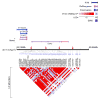Haplotypes of the estrogen receptor beta gene and breast cancer risk
- PMID: 17935138
- PMCID: PMC2796078
- DOI: 10.1002/ijc.23127
Haplotypes of the estrogen receptor beta gene and breast cancer risk
Abstract
Exposure to exogenous (oral contraceptives, postmenopausal hormone therapy) and endogenous (number of ovulatory cycles, adiposity) steroid hormones is associated with breast cancer risk. Breast cancer risk associated with these exposures could hypothetically be modified by genes in the steroid hormone synthesis, metabolism and signaling pathways. Estrogen receptors are the first step along the path of signaling cell growth and development upon stimulation with estrogens. The National Cancer Institute Breast and Prostate Cancer Cohort Consortium has systematically selected haplotype tagging SNPs in genes along the steroid hormone synthesis, metabolism and binding pathways, including the estrogen receptor beta (ESR2) gene. Four htSNPs tag the 6 major (>5% frequency) haplotypes of the ESR2 gene. These polymorphisms have been genotyped in 5,789 breast cancer cases and 7,761 controls nested within the American Cancer Society Cancer Prevention Study II, European Prospective Investigation into Cancer and Nutrition, Multiethnic Cohort, Nurses' Health Study and Women's Health Study cohorts. None of the SNPs were independently associated with breast cancer risk. One haplotype of the ESR2 gene was associated with breast cancer risk before correction for multiple testing (OR 1.17, 95% CI 1.07-1.28, p = 0.0007). This haplotype remained associated with breast cancer risk after adjustment for multiple testing using a permutation procedure. There was no statistically significant heterogeneity in SNP or haplotype odds ratios across cohorts. These data suggest that inherited variants in ESR2 (while possibly conferring a small increased risk of breast cancer) are not associated with appreciable (OR > 1.2) changes in breast cancer risk among Caucasian women.
Copyright 2007 Wiley-Liss, Inc.
Figures
Similar articles
-
Sequence variants of estrogen receptor beta and risk of prostate cancer in the National Cancer Institute Breast and Prostate Cancer Cohort Consortium.Cancer Epidemiol Biomarkers Prev. 2007 Oct;16(10):1973-81. doi: 10.1158/1055-9965.EPI-07-0431. Cancer Epidemiol Biomarkers Prev. 2007. PMID: 17932344
-
Genetic polymorphisms of the GNRH1 and GNRHR genes and risk of breast cancer in the National Cancer Institute Breast and Prostate Cancer Cohort Consortium (BPC3).BMC Cancer. 2009 Jul 29;9:257. doi: 10.1186/1471-2407-9-257. BMC Cancer. 2009. PMID: 19640273 Free PMC article.
-
Estrogen receptor genotypes and haplotypes associated with breast cancer risk.Cancer Res. 2004 Dec 15;64(24):8891-900. doi: 10.1158/0008-5472.CAN-04-1256. Cancer Res. 2004. PMID: 15604249
-
Joint effect of estrogen receptor beta sequence variants and endogenous estrogen exposure on breast cancer risk in Chinese women.Cancer Res. 2003 Nov 15;63(22):7624-9. Cancer Res. 2003. PMID: 14633679
-
A systematic review of the relationship between polymorphic sites in the estrogen receptor-beta (ESR2) gene and breast cancer risk.Breast Cancer Res Treat. 2011 Feb;126(1):37-45. doi: 10.1007/s10549-010-0891-2. Breast Cancer Res Treat. 2011. PMID: 20390341
Cited by
-
Estrogen receptor-Beta variants are associated with increased risk of Alzheimer's disease in women with down syndrome.Dement Geriatr Cogn Disord. 2011;32(4):241-9. doi: 10.1159/000334522. Epub 2011 Dec 8. Dement Geriatr Cogn Disord. 2011. PMID: 22156442 Free PMC article.
-
Genetic variation in ESR2 and estrogen receptor-beta expression in lung tumors.Cancer Epidemiol. 2013 Aug;37(4):518-22. doi: 10.1016/j.canep.2013.03.020. Epub 2013 Apr 23. Cancer Epidemiol. 2013. PMID: 23619141 Free PMC article.
-
Current evidence on the relationship between rs1256049 polymorphism in estrogen receptor-β gene and cancer risk.Int J Clin Exp Med. 2014 Dec 15;7(12):5031-40. eCollection 2014. Int J Clin Exp Med. 2014. PMID: 25664002 Free PMC article.
-
Estrogen and progesterone-related gene variants and colorectal cancer risk in women.BMC Med Genet. 2011 May 31;12:78. doi: 10.1186/1471-2350-12-78. BMC Med Genet. 2011. PMID: 21627810 Free PMC article.
-
Isoflavone, polymorphisms in estrogen receptor genes and breast cancer risk in case-control studies in Japanese, Japanese Brazilians and non-Japanese Brazilians.Cancer Sci. 2009 May;100(5):927-33. doi: 10.1111/j.1349-7006.2009.01118.x. Epub 2009 Feb 26. Cancer Sci. 2009. PMID: 19298602 Free PMC article.
References
-
- Anderson E, Clarke RB. Steroid receptors and cell cycle in normal mammary epithelium. J Mammary Gland Biol Neoplasia. 2004;9:3–13. - PubMed
-
- Forsti A, Zhao C, Israelsson E, Dahlman-Wright K, Gustafsson JA, Hemminki K. Polymorphisms in the estrogen receptor beta gene and risk of breast cancer: no association. Breast Cancer Res Treat. 2003;79:409–13. - PubMed
-
- Gold B, Kalush F, Bergeron J, Scott K, Mitra N, Wilson K, Ellis N, Huang H, Chen M, Lippert R, Halldorsson BV, Woodworth B, et al. Estrogen receptor genotypes and haplotypes associated with breast cancer risk. Cancer Res. 2004;64:8891–900. - PubMed
-
- Maguire P, Margolin S, Skoglund J, Sun XF, Gustafsson JA, Borresen-Dale AL, Lindblom A. Estrogen Receptor Beta (ESR2) Polymorphisms in Familial and Sporadic Breast Cancer. Breast Cancer Res Treat. 2005;94:145–52. - PubMed
-
- Rosenkranz K, Hinney A, Ziegler A, Hermann H, Fichter M, Mayer H, Siegfried W, Young JK, Remschmidt H, Hebebrand J. Systematic mutation screening of the estrogen receptor beta gene in probands of different weight extremes: identification of several genetic variants. J Clin Endocrinol Metab. 1998;83:4524–7. - PubMed
Publication types
MeSH terms
Substances
Grants and funding
LinkOut - more resources
Full Text Sources
Medical



